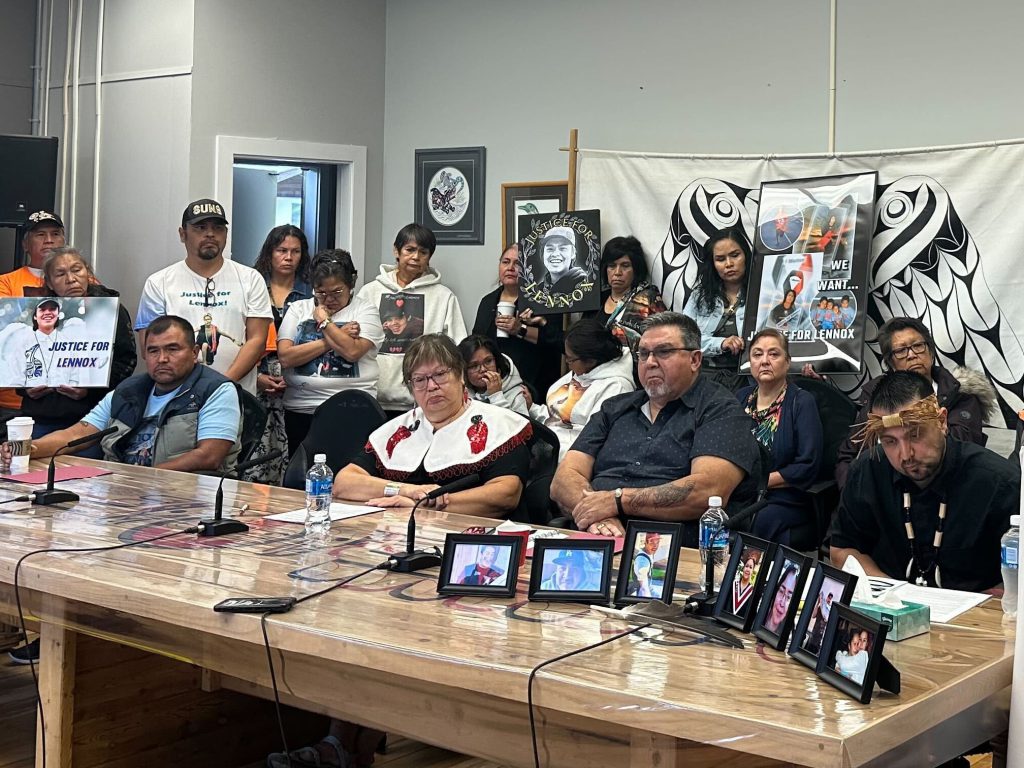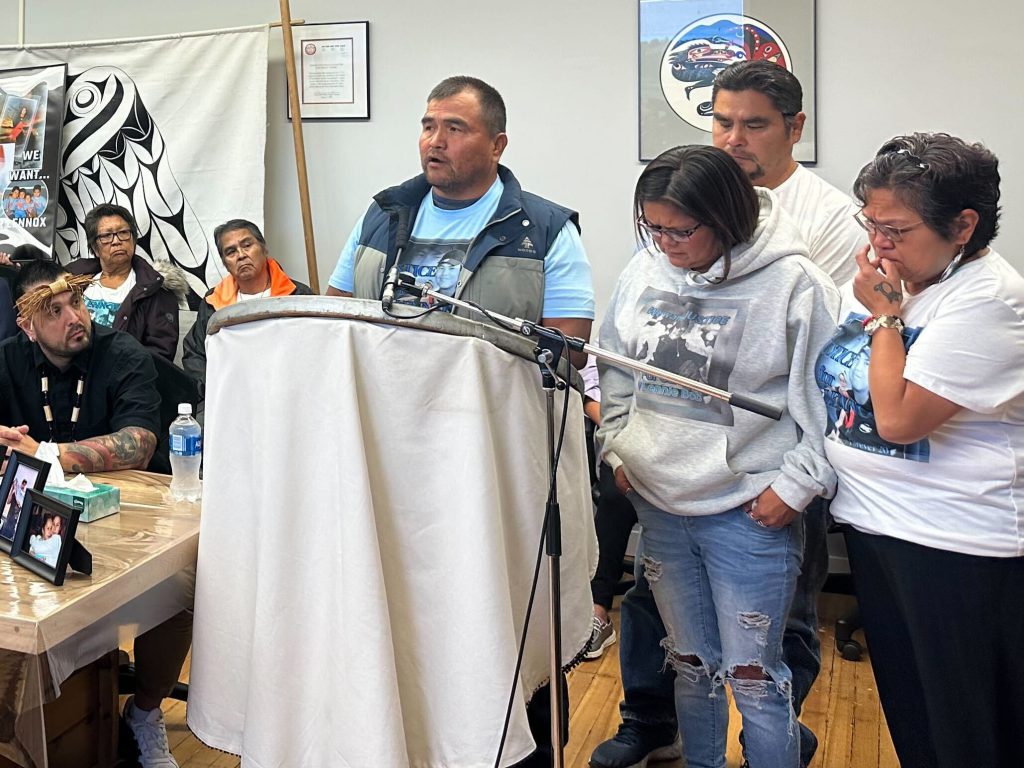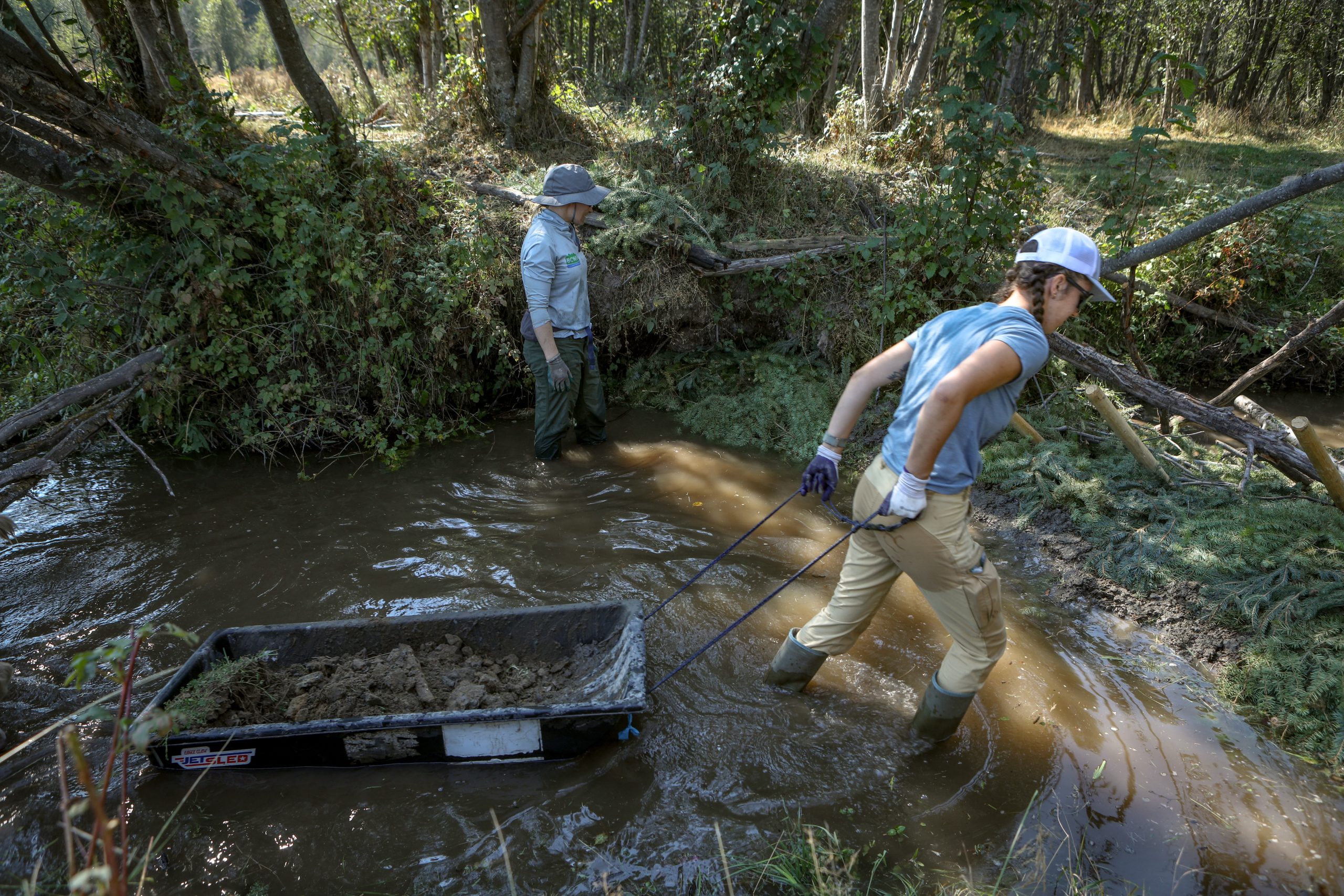Nuu-chah-nulth Tribal Council declares state of emergency over opioid crisis: ‘Enough is enough’
Leaders are calling for more resources and mental health supports in their 14 communities, saying they are ‘losing too many, especially young people, to this crisis’


Surrounded by photos of their kin who were lost to the unrelenting opioid crisis, Nuu-chah-nulth leaders declared a state of emergency in their 14 tribal council communities.
“Today, we come before you Nuu-chah-nulth Tribal Council strong, to say — enough is enough,” said president of Nuu-chah-nulth Tribal Council (NTC) Cloy-e-iis Judith Sayers on Thursday.
“This is a real emergency,” she added in a statement. “We are losing too many, especially young people, to this crisis.”
c̓išaaʔatḥ (Tseshaht) First Nation Chief Councillor and NTC board member waamiiš Ken Watts sat behind seven framed photographs of community members who have died, and listed each of their names in remembrance.
Other community members held banners and wore sweaters with photos of Lennox, a 20-year-old Nuu-chah-nulth man who died earlier this month as a result of the opioid crisis.
“This young man who was lost over a weekend, where, I won’t go into details, but he had a lot going for him,” said Curtis Dick, a family spokesperson who stood next to Lennox’s mother and auntie as they grieved.
“We want to put a call for justice for Lennox, on behalf of the (family), for this young man who was taken from our community at such a young age.”
Leaders called on governments and health services to better resource and fund mental health supports throughout NTC. The press conference on September 19, was held at the NTC office — formally Caldwell Hall, a wing of the Alberni Indian Residential School, which is slated for demolition this year.
“Everyone you see here has families that went to this school,” said Watts, as Elders nodded in agreement.
“The trauma happened right here.”
‘Shocking’ statistics
The town of “Port Alberni” located centrally on the west coast of “Vancouver Island,” lies within the homelands of the Hupačasath and c̓išaaʔatḥ First Nations, both members of the NTC. The town of roughly 20,000 residents holds the second highest number of overdose deaths in the province. It’s second only to the Downtown Eastside in “Vancouver”.
“That’s shocking, that’s shocking” repeated Sayers, who said the NTC doesn’t have enough capacity or dollars to deal with the immense amount of loss. “Our workers are overworked, the burnout is real.”
The announcement follows the recent jarring report from the First Nations Health Authority (FNHA) which revealed First Nations life expectancy had dropped by six years between 2017 and 2021. The report said the decline is largely due to COVID-19 and the opioid crisis.

In “British Columbia”, First Nations people make up only four per cent of the population, yet account for 20 per cent of toxic drug related deaths. The lack of detoxification facilities exacerbates the issue, with only 10 facilities managed by the FNHA across the entire province. Island Health has two facilities, in “Nanaimo” and “Victoria.”
“So what happens if you want to get into detox and you meet the criteria? You have to be almost like a lotto winner to be able to get in,” said NTC vice president Les Doiron.
Earlier in the week, on Sept. 16, the NTC held a meeting with the B.C. Ministry of Mental Health and Addictions, Island Health, the FNHA, and other agencies to begin discussions about how the agencies can come together to to invest in the health of Nuu-chah-nulth people. But NTC leadership said the federal government failed to attend.
“We call on the prime minister to ensure that he gets involved in this. It’s too important,” said Sayers. “We need them at the table.”
Sayers says they’re looking for “adequate funding” for Nuu-chah-nulth’s 14 individual First Nations, as well as the NTC, which acts as a service provider in areas like addictions and mental health.
“We will continue to do that, but as I mentioned, the sustainability and burnout of our staff is real, and we do need more resources,” she said.
The tribal council is asking for a detoxification centre and rehabilitation centre that meet the needs of the 14 remote communities, as well as funding to devise community-specific solutions.
“Sometimes, we don’t feel that (colonial) governments understand the immensity of the Nuu-chah-nulth territories,” said Sayers, which span much of the west coast of “Vancouver Island,” including several inhabited islands.
The NTC divides about 300 km of territory into three regions — the southern, central and northern region — altogether totalling approximately 10,000 members, according to the tribal council.
“We need help in all those regions, not just one community, but every community,” said Sayers.
“When we invest in mental health, education, housing and economic development, we can create a future where fewer people turn to opioids to cope with trauma and pain.”
Leaders say more supports needed
Watts believes “governments and society” aren’t doing enough to support relatives who have lost loved ones from the opioid crisis. He says that’s why c̓išaaʔatḥ will be asking candidates in the upcoming provincial election what they plan to do for grieving families.
“Have you ever heard the cry of a mother and a father who have lost their loved one?” he asked.
In the Alberni Valley, c̓išaaʔatḥ has developed the Alberni Valley Toxic Poisoned Drugs Crisis Strategy, which it hopes to implement through multi-agency funding. The strategy takes a holistic approach, including preventative measures such as language revitalisation, traditional teachings through programming, and tackling transportation issues; as well as harm reduction and recovery.
“It won’t solve all the problems but it’s a start and we want it funded,” Watts said. He’s hoping other Nuu-chah-nulth First Nations follow suit to develop their own community-specific strategies.
Meanwhile, ʕaaḥuusʔatḥ (Ahousaht) is about to open a full-time wellness centre at the former site of the Ahousaht Residential School on the community’s primary home of “Flores Island.”
ʕaaḥuusʔatḥ Chief Councillor Naasathluk (John Rampanen) hopes it will open up land-based healing opportunities for Youth and the community to engage with the lands of their ancestors, find medicines, and restore well-being.
He said ʕaaḥuusʔatḥ has applied for federal and provincial funding to help with operations of the wellness centre.
“Unfortunately, it’s been very challenging to secure those funding dollars, so we’ve been very creative on how we’re going to be able to initiate this ourselves.”
NTC president worried about new provincial policy
Nearly 80 per cent of Indigenous people in “B.C.” live in urban and off-reserve areas. Doiron reflected on the damage caused by the Indian Act resulting in the overcrowding of reserves that has caused Indigenous people to move away from their territory, sometimes impacting relationships and connection to culture.
“You have to move to Campbell River or Port Alberni, wherever it is to find work and accommodation,” he said. “Couch surfing is what happens to a lot of our people, because it’s just so expensive to be able to get a place.”
Sayers said she’s worried about how the new involuntary treatment regime introduced earlier this month by “B.C.” Premier David Eby — which shifts away from harm reduction and towards a more penal approach to drug policy — will affect urban Indigenous people.
“I’m not sure how this involuntary care is going to roll out,” she said after confirming that Eby hadn’t consulted with NTC on the new policy.
“We know there are not enough supports out there, and so in some ways it’s a good thing, but I have some questions about how it will actually happen on the ground, and making sure families are informed,” said Sayers.
Rampanen added that Nuu-chah-nulth people “have been in a state of crisis for too long.”
“Intergenerational impacts stemming from the residential school era and displacement brought upon through colonialism have severely impacted the holistic nature of who we are as nuučaan̓uł people,” he said in a statement.
“We seek true reconciliatory action from the provincial and federal governments in a sustained manner to support our efforts to overcome these barriers.”
Author
Latest Stories
-
‘Bring her home’: How Buffalo Woman was identified as Ashlee Shingoose
The Anishininew mother as been missing since 2022 — now, her family is one step closer to bringing her home as the Province of Manitoba vows to search for her
-
St. Augustine’s survivor hopes for closure after evidence of 81 unmarked graves released
50 years after the residential ‘school’ closed, shíshálh Nation announces evidence of many burial sites. A Tla’amin Elder wonders how many more children died












